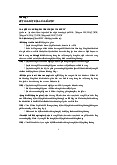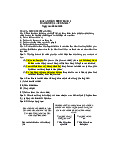










Preview text:
Chap Ch t ap e t r e r 3 : 3 Sales Start up
Business involves buying and selling. Customers, or buyers, want to buy a product or service;
the sales person simply has to convince them that this product is the one they need. However,
sales isn9t simply about information, and trust.
Some of the key concepts in sales are:
Feature – an aspect of the product or service. It could be its size, speed, color, function, etc.
Benefit – this is what the customer gains from having the product or service. It may be
tangible (cleaner clothes, faster travel, etc.) or intangible (convenience, enhanced social
status, etc.). Customers don9t buy features, they buy benefits.
Active listening – asking questions and actually listening to the customers9 answers,
finding out what they want and don9t want, and understanding how they feel and what
their issues are, is of vital importance to the sales person.
USPs – these are or service has over its rivals.
FABs – or the links between the product description, its advantage over rival products, and the gain
that the customer has from using it.
But how do sales people actually achieve sales? Sales techniques are constantly developing.
However, the traditional selling model which is still widely taught today is the Seven steps of selling:
1. Planning and preparation: know your product, know your market, know the competition, prepare your presentation
2. Opening: smile, be professional, explain the purpose of your visit, ask how long the
prospective buyer has and if you can take notes 20
3. Questioning: to confirm or discover the major benefit(s) that the product / service will
give the customer, and to build relationships
4. Presentation: focus on the unique benefit that the customer will get from the product,
matching the benefits with the customers9 needs, priorities, and motives
5. Overcoming objections: avoid argument and confrontation; understand the issues and then address them
6. Closing: the best close is short and sweet, all the key points having been covered
7. After-sales follow-up: the completing of all the necessary paperwork, ongoing contact to
make sure that the customer is happy and to resolve any problems. Questions:
1. Why don9t customers buy features but benefits?
2. How is the importance of USPs?
3. Why do sales people usually perform seven steps of selling?
4. What are your opinions about these seven steps?
5. Find words or phrases in the text which mean:
- Something that a particular product has or does - Competitors
- Very necessary or highly important
- The state of being face to face
- Anything prompting to action Wordcheck
Complete the puzzle and find the key word in 10 down. 10 1 2 3 4 5 6 7 8 9 21 Across
1. Those are our standard terms. What price did you have in ? (4) 2. If we
to a unit price of $55, what credit terms could you offer us? (6)
3. We can9t offer 90 days, but 60 days be possible. (5)
4. Before we finish, could we just go
what we9ve agreed once again? (4)
5. We can9t agree to this proposal. Can you suggest some ? (12) 6. What
will you give me on the list price? (8) 7. There9s a clause for cancellation. (7)
8. A two-week credit period wouldn9t work for us. It9s too . (5)
9. If we placed a larger order, would you the discount to 15%? (8) Down
10. Try to reach an agreement by discussion. (9) Brainstorming
1. Needs, wants, and preferences
a. Read the text and discuss the questions. i.
Why do you think it is important for companies to know their customers9 key expectations? ii.
What are your key expectations for a mobile phone? iii.
What is the difference between a need and a preference?
Trying to keep the customers satisfied
We are all consumers – and we are all different. When you buy a new mobile phone, you have a
set of expectations. You may want it to be small and attractive. Or you may want it to have
internet access. Or you may simply want it to be cheap and easy to use. If the product doesn9t
meet your key expectations, you will be dissatisfied. And the next time you want a new mobile
phone, you will probably buy it from a different manufacturer.
Every customer has needs, wants, and preferences.
• A need is something you require. It could be goods or services. (a dictionary)
• A want is what it must be like. It is a general description of what you require. (bi-
lingual, with business terminology)
• A preference is your personal choice, it9s the ideal product. You may or may not find it. (not too expensive) 22
b. Imagine you have the following needs and complete the table. Need Want Preference I need… It must be… I would prefer… A laptop A motorbike A fast-food restaurant A pair of trainers A TV A handbag
c. Work in groups and discuss the questions: imagine you are a manufacturer of laptop
computers, which key customer expectations would you choose to meet?
2. Are you a good manager?
Read number 1 and choose the best solution from A, B, or C. Then follow the instructions. If
you read Go to 10, then read the next part of the problem under 10. If you read Go to 8, then
read number 8. Continue until you find the best solution to the problem. Use a dictionary if
you need any help, and good luck!
1. You are the manager of a mail-order company with about 30 employees, and more
than half of them are parents. One morning, a group comes to you to ask the
company to set up a daycare center to look after the children. You would:
A. Explain that you don9t have to do this by law, and that it is too expensive. Go to 10.
B. Agree to set up a daycare center – it would keep the employees happy. Go to 8.
C. Say you will look into the matter. Go to 6.
2. Why are you reading this? Read the instructions once more and try again. 23
3. The group reports back with the figures. They show that a small daycare center for 4
children can be run for about $20,000 per year. You would:
A. Go ahead and set up the daycare center. Go to 4.
B. Ask the Finance Department to check the figures. Go to 8.
4. Staff morale is very high. After 2 years, the demand for the daycare center is even
bigger. There are now 11 children. It costs $75,000 a year, and the cost is rising. You would:
A. Limit the daycare center facilities to 10 places on a first come, first served basis. Go to 7.
B. Allow the daycare center to continue until you can find another solution. Go to 11.
C. Close the daycare center down. Go to 17.
5. The head of finance comes to you. He is an important person in the company. He
says he cannot allow his staff to waste time with research like this – the parents
should do the study themselves. You would:
A. Accept this decision. Go to 3.
B. Say that the Finance Department must help the committee with the full study. Go to 12.
6. You find that you do not have time to do the research yourself. You would:
A. Ask the Finance Department to conduct a study. Go to 8.
B. Ask the parents themselves to come up with a proposal. Go to 3.
C. Organize a committee made up from personnel, finance, and the parents themselves. Go to 5.
7. One of the directors is refused a place for her child in the daycare center. She is furious. You would:
A. Make an exception in her case, and give her a place in the daycare center. Go to 18.
B. Tell her that the company policy is clear, and that she cannot be helped. Go to 9.
8. The Finance Department tells you that a daycare center is out of the question – it is far too expensive. You would: 24
A. Tell the parents that, unfortunately, the company cannot offer childcare facilities. Go to 17.
B. Form another committee to look at other proposals. Go to 6.
C. Go ahead anyway; a daycare center may be expensive, but you cannot afford
to lose your workers. Go to 4.
9. At a board meeting, the director calls for your resignation. You have made a mess of
the company9s finances and too many bad decisions. Start again.
10. A number of parents resign. The Personnel Department says you have to do
something about childcare; hiring new staff all the time is expensive. You would:
A. Have another look at the problem. Go to 6.
B. Ask the Finance Department to look at the problem. Go to 8.
C. Ask the group of parents to study the cost of a daycare center. Go to 3.
11. The Finance Department was right: the high cost of the daycare center is affecting
the company9s finances very badly. You would:
A. Close the daycare center down. Go to 17.
B. Cut the workers9 salaries by 20%. Go to 14.
C. Allow the daycare center to continue until you can find another solution. Go to 19.
12. The committee says that a daycare center is the best solution, but the most expensive.
An alternative is to pay for part of the cost of sending children to a small, local
nursery. (A nursery is a place where parents can leave their children for the day,
during working hours). You would:
A. Go ahead with the daycare center. Go to 8.
B. Choose the subsidized nursery. Go to 15.
C. Ignore the problem and hope it will go away. Go to 1.
13. The parents realize why you have made your decision when they are told all the
facts. They are pleased with the new system and it works well. Congratulations: you have found the best solution.
14. The head of the company calls you into his office. he shouts. Start again.
15. Some staff don9t like the plan to use an outside nursery. Two of the parents say they
will resign if you do not choose a proper daycare center. You would: 25
A. Explain your decision fully at a company meeting. Go to 13.
B. Accept the resignations. Go to 16.
C. Change your mind and go ahead with the daycare center. Go to 11.
16. You actions make the staff very unhappy. They think you are very unreasonable.
However, there are no more resignations, and the scheme works well. This is one
solution, but not the best. Try again.
17. The parents are angry with your decision. Seven of them hand in their notice. Go to 14.
18. Three other members of staff ask for places in the daycare center. You gave the
director a place, so they want one, too. You would:
A. Create more places in the daycare center. You have to be fair to everyone. Go to 19.
B. Say you cannot help. There is no money available. Go to 17.
19. The company has had a bad year, and loses money. It is clear that the daycare center
costs too much money. You would:
A. Keep to your decisions and carry on. Go to 14.
B. Tell the parents they must pay for part of the daycare center themselves. Go to 17. Reading Sales techniques
A. Sell benefits, not features
When you are selling, the customer doesn9t want to know about the features of a
product. They want to know how it is going to benefit them. Is it going to make them
more attractive? Or save time? Or help them to work more efficiently?
B. Differentiate your product
You must come up with at least three ways in which your product is different from the
competition. These are called USPs – Unique Selling Points. For example, your product
could be faster, cheaper, and smaller than the competition.
C. Meet your customer face-to-face
You need to meet your customers, especially if you are new. It is not worth spending a
fortune on newspaper advertising or direct mailing for first-time entrepreneurs. 26
D. Let the customer tell you what they want
You need to understand your customer before you can sell him or her something. Don9t
start 8selling9 something until your customer has talked about themselves. E. Learn to listen
Sales people who do most of the talking usually lose the sale! Listen carefully and don9t
jump to conclusions. Take notes and concentrate on what your customer is saying. Find
out what your customer really wants by asking lots of questions.
F. Sell to people who buy
If you are trying to sell a product, don9t try and sell it to someone who has never bought
it before. Sell your product to someone who already has one. Show your clients how
yours is superior to the competition.
G. Turn your customers into salespeople
If your customers are happy, they are going to tell other people. Nearly 85% of sales are
the result of word of mouth. So think about how you can create satisfied customers.
They will do your advertising for you!
1. Work in pairs. Discuss these questions.
a. What persuades you to buy something? Is it an advert? A friend9s advice? A magazine or
internet article? A sales person?
b. Have you ever bought more than you planned to from a shop? What were the reasons?
2. Read the article and decide if these sales pitches are effective (E) or not effective (NE). Explain why.
a. This product has a camera, an alarm clock, and a calculator. NE sell benefits, not features
b. This machine is going to help you organize your life.
c. This product is smaller, cheaper to run, and has a longer battery life than our major competitor.
d. Right, let me tell you all about our products.
e. I see. Can you give me an example of what you mean?
f. Tell me about the product you are using at the moment.
3. Find words and expressions that mean the following:
a. Distinctive parts or aspects of something (paragraph A) 27
b. To make something different from other things (paragraph B)
c. Sending adverts through the post (paragraph C)
d. To decide too soon that something is true (paragraph E) e. Better than (paragraph F)
f. Being told about something, rather than reading about it (paragraph G) Speaking 1. Business know-how
Knowing about your strengths helps you find your ideal job. This quiz helps you analyze your dreams and passions. Find your own USPs
• What excites you in the world?
• What angers you in the world?
• What business would you like to start?
• What would you write a best-selling book about?
• Write down five talents that you have.
• Write down two talents that you don9t use.
• Who lives the life you most envy and what is it like?
2. You are going to a sales conference in Paris. You have a morning sightseeing tour and the
conference starts in the afternoon. Prepare your itinerary, then talk with your partner. Writing 1. Emails: Complaining From: Megan Byrne To: Derek Adams
Subject: Delivery of digital cameras Dear Mr. Adams,
I am writing to complain about the delivery of 30 digital cameras, order #WP315, which we received today.
I am sorry to say that the packaging was damaged, and the cameras are not of saleable
quality. I attach photographs of the damage.
Please arrange to have them collected, and send us a replacement consignment as soon as possible. 28
Thank you for your assistance in this matter. Yours sincerely Megan Byrne Sales Manager, TechnoWorld
2. Emails: Dealing with complaints From: Derek Adams To: Megan Byrne
Subject: Delivery of digital cameras Dear Ms. Byrne,
Thank you for your email concerning your order #WP315. We are very sorry to hear about
the problem with the delivery of this order. Our carrier is investigating the matter.
We will send you replacement cameras, and will collect the damaged items free of charge.
Please accept our apologies for the inconvenience. We look forward to doing business again with you in the future. Yours sincerely, Derek Adams Stock Controller Dilemma Is grey the new black? Brief
Many producers of branded goods refuse to distribute through supermarket chains, fearing that
price-cutting could damage their brand image. They distribute exclusively through selected
retailers. Grey marketers challenge this by obtaining branded goods through alternative supply
routes and selling them at much cheaper prices.
Best Value is a leading UK supermarket chain that has been offered a genuine branded jeans at a very heavily discounted price. The brand-owner, GenX, is aware of
the situation and has threatened legal action if Best Value sells the jeans. Best Value could sell a
lot of the jeans and even the legal threats from GenX could generate positive publicity.
However, losing a major legal battle could be costly and sales of Best Value9s own brand of jeans could suffer. 29 Task
Discuss the best course of action to take. Possible options include: 1. Refuse the GenX 250 jeans.
2. Sell the jeans but hope to get GenX9s permission by negotiating an acceptably high retail selling price.
3. Accept the shipment and sell the jeans at the heavily discounted price risking legal action from the brand-owner. 30




